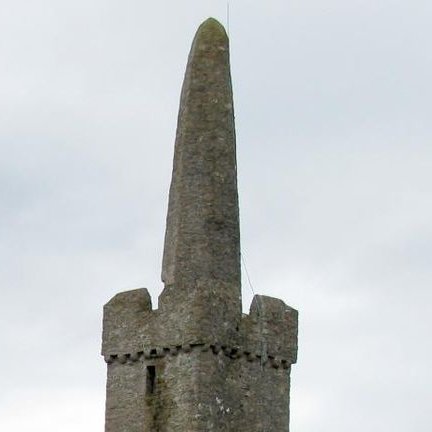
Unfinished business. And it's not really many more houses than most English counties. A brief reboot of MonasteryQuest™!
To be honest I only started the first to help me put Abbey Dore and Kilpeck Priory in context for a video I never made. Maybe this will take me full circle!
To be honest I only started the first to help me put Abbey Dore and Kilpeck Priory in context for a video I never made. Maybe this will take me full circle!

... and Cardiff Greyfriars. and yeesh. yes I will do the mendicants in the Principality. there's not many.
https://twitter.com/DrJACameron/status/1355140794504667136
May as well stay down here and do Glamorgan first. Ewenny Priory, very famous, probably should have been myself, will I ever now hmm who knows. not as idyllic setting as I thought but convenient. 

Ewenny was a small Benedictine house, £78 gross/59 net (not shabby), f. 1141. Aside from the the church, the best survival is extensive defensive precinct walls/towers. The claustral buildings were replaced by the Carne's mansion which in turn was replaced 1803-5, and is private. 





Ewenny's priory church survives, shorn of its N transept and S chapels, but with the oddly hybrid rib/barrel vault over the E arm. Vestigial middle story gives transept swagger. Oddly was built in the 1120s before a monastery had even been organised. Turner painted it, of course. 







Margam, Cistercian house f. 1147 from Clairvaux. £181 net in 1535/6. Nave without clerestory and walls heavily remodelled survives as parish church (which it's hard to find interior pics of?! is it open?), with SE pier of the crossing and bits of walls visible of 13thc east arm. 







Of course the stunner at Margam is the c.1200 chapter house - one of the earliest in a long line of monumental, centrally planned ones in England, rivalling the largely vanished one at Dore (Herefordshire). Sadly, the vault collapsed in 1798. 





Neath Abbey, also Cistercian, but f. as Sauvignac 1129. Church rebuilt c.1280 with some Crown support. Post-Dissolution mansion built using dormitory and abbot's lodging. Later encroached by industry, W range used for copperworks furnaces. Cleared 1924-35 by local antiquarians. 





And that's Glamorgan! just five houses! I'm just going zig zag around Wales rather than go strictly alphabetically as I'm partly still working out how to categorise the counties anyway. Guess I'll do Monmouthshire next as it's similarly English-adjacent.
Abergavenny Priory, Benedictine house f. 1087 from St-Vincent, Le Mans. Luckily I've been so I don't need to figure out there's not really much to say as architecturally, it's mucked about and quite boring. but the church hall to the S is basically built on the refectory. 



Let's have a quick segue to Abergavenny's mother church St-Vincent Le Mans and a reminder it's kinda more depressing a whole great medieval church gets flattened in /1806/ because it gets in the way of military drills 



Chepstow Priory, £32 net (rubbish). Wish I'd gone over the bridge from Bristol to this now. absolute wreck of a church. Aisles chopped off, crossing lost, arcades mostly mutilated. Claustral range excavated 1970s. Don't think the E arm is known. At least I know where to park now. 







Grace Dieu Abbey. Cistercian, f. from Abbey Dore 1226. £19 net in 1535/6 (lol). terrible. nobody knows precisely where it was because it was so rubbish.
(not to be confused with the Augustinian nuns in Leicestershire.

(not to be confused with the Augustinian nuns in Leicestershire.
https://twitter.com/DrJACameron/status/1251126862316744704)


Llantarnam Abbey a slightly more respectable Cistercian house, at £79 net. f. from Strata Florida (see below I guess) 1179 tho might've moved. All that remains is a big ol' barn with no roof N of the house. Claustral core and church replaced with mansion c.1588 and rebuilt 1834-5 



Llanthony Prima. A lordly early 12thc foundation of Austin Canons got hammered after English power collapsed here after death of Henry I in 1135. Mostly moved to L-Secunda in Gloucester, but this site was held and a lovely West-Country Early Gothic church was put up in the 1190s 





also quite a lot of progressive collapse at Llanthony in modern times: E window fell out 1777, E end totally, then E lancets in 1803; followed by part of the N arcade in 1837.
Parish church in the former infirmary to the S of the cloister. Hotel on prior's lodgings? yes please



Parish church in the former infirmary to the S of the cloister. Hotel on prior's lodgings? yes please




It doesn't look like there's any archaeological evidence for the T*mplar/ later Hospitaller preceptory at Kemeys Commander, but come on, it's called KEMEYS COMMANDER what a cool name 

Malpas Priory, £14 net, some nothing Cluniac cell from Montacute in Somerset, probably behind this neo-Norman 1850 parish church which has real 12thc bits in it 



Monmouth Priory, £56 net, Benedictine, f. 1075, from Abbey St-Florent in Saumur, Anjou. Of the church, well, one pier and tower arch basically, it was completely rebuilt twice. Nice big oriel window from the prior's lodging to N though 







Newport Austin Friars f. 1377. I don't really "do" English (oof, well whatever, it's all colonial at this point) mendicants (if you can tell me their Valor valuation please do as I can't find it) but it's pretty funny they've got a Debenhams on top now 





Tyndyrn, f.1131 from L'Aumône (7th daughter of Citeaux), second Cistercian house in Britain after Waverley. The monastic buildings are on the N side how odd!
Otherwise never heard of it.


Otherwise never heard of it.



oh wait I recognise it now. that lad's done a great job on the impaled pointed trefoils, Eddie aside.
(one of Graham Chapman's last roles)



(one of Graham Chapman's last roles)

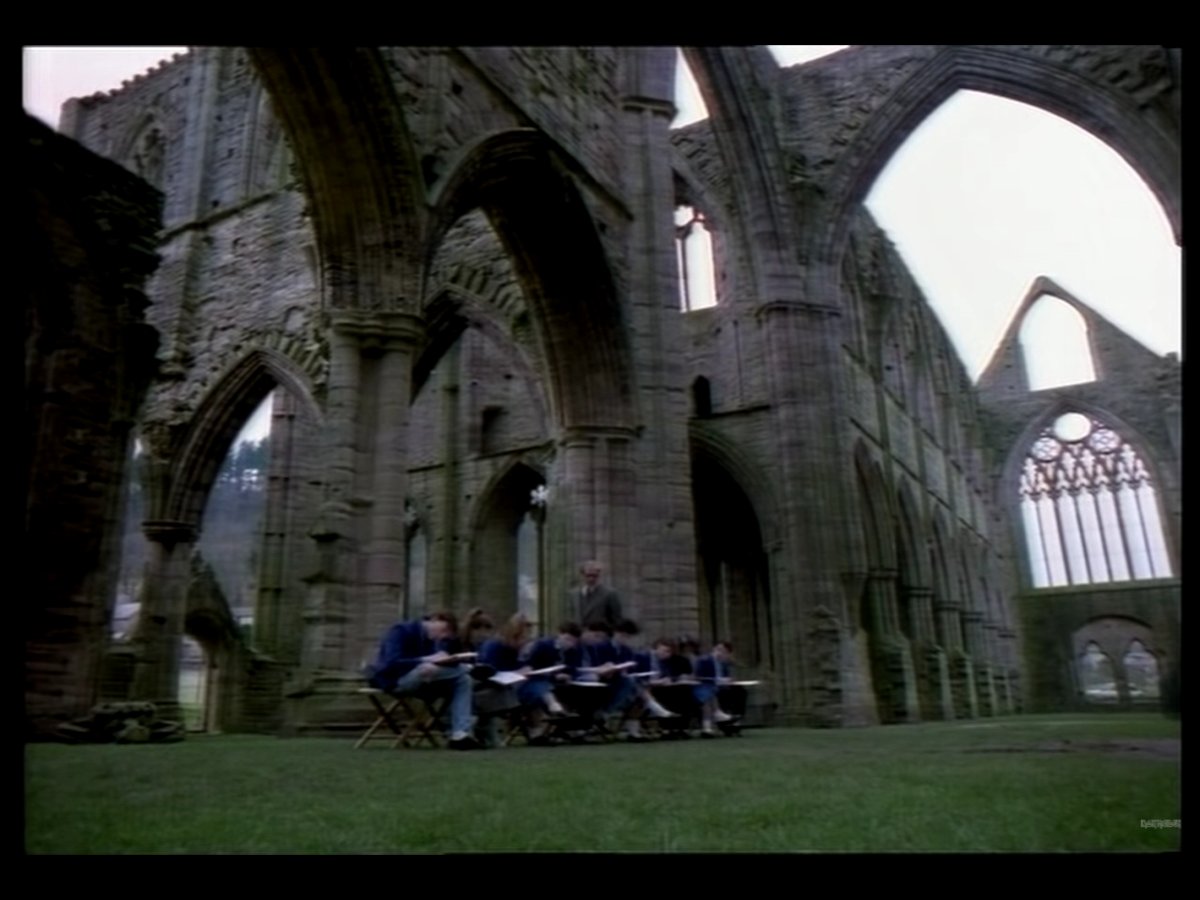


Usk Priory: Benedictine women f. after 1176. W parts retained as parish church as had parochial N aisle. Beefy Romanesque crossing now chancel, w original (re-coloured) rood screen. Victorian house built over claustral range, gatehouse survives though.
And that's Monmouthshire!



And that's Monmouthshire!


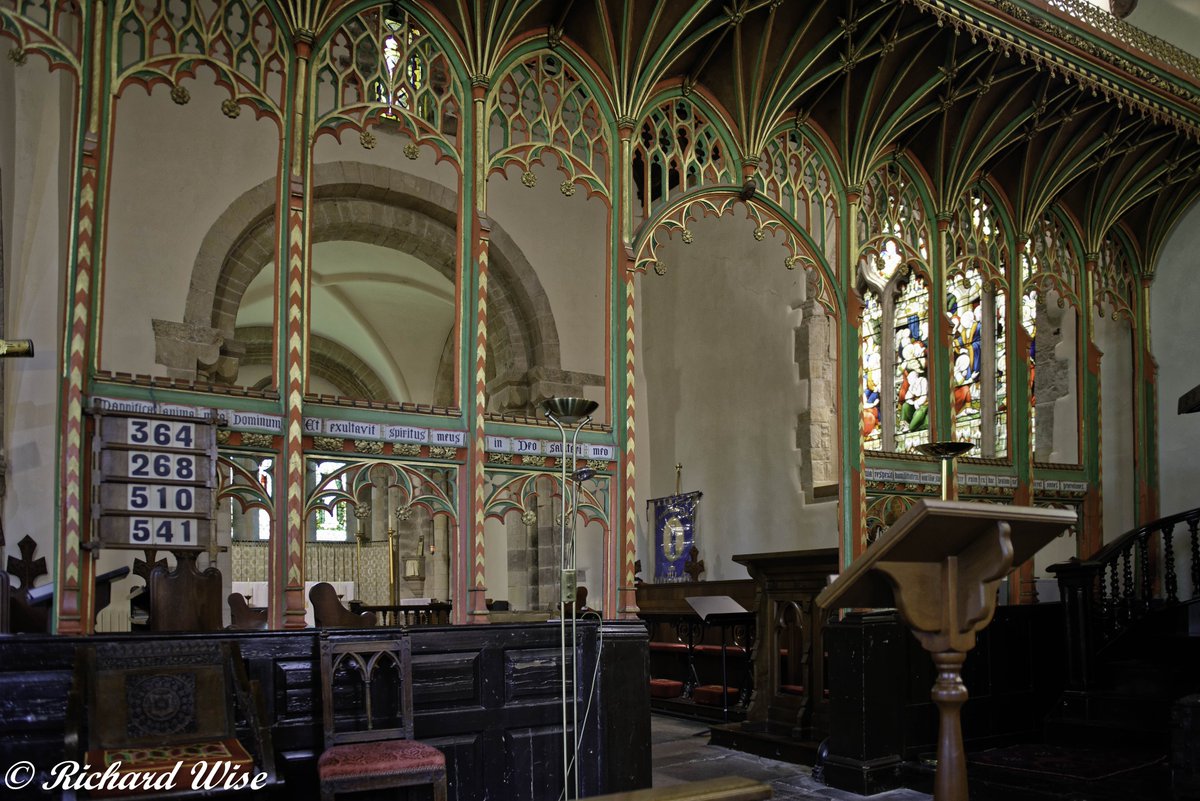

so this is where we are. I guess up to Powys next, where I may actually have visited nearly every site(!), but after that I only have the Pevsner (or rather BoW) for Clwyd so hmm will be a bit more in the dark 

Brecon Priory was f. from Battle Abbey in 1093, along with the castle as an English landgrab. It was only £112 net in 1535 and never had more than eight monks. The survivals are a bit of a jumble: the prior's lodging became a residence with the west range used as its stabling. 





The church survived as parochial and in 1923, first monastic church to become an Anglican cathedral since Henry VIII. The presbytery and transepts were rebuilt in the 1230s by masons connected to Hereford Cathedral, but the vault was only (bravely) realised by Scott in 1861-2. 







As I'm doing mendicants, can do the other Brecon Priory: a Dominican house f. sometime mid 13thc, which was granted to the Bishop of St Davids to become a college and is now an independent boarding school. The canteen and dining hall is in two partly medieval halls. 







The school chapel at Brecon is of course, the former 13thc friary church, and one of the few standing mendicant churches in Britain. The single aisled nave lost its arcade and is open to the sky, but the friars' choir retains shafted lancets and double piscina/quadruple sedilia. 







I've been thinking about Cwmhir all night. Why found a monastery here, in the middle of nowhere, at all, never mind giving it a 14-BAY-NAVE.
Can say driving here and back to civilisation takes the best part of an hour out of your day, to see effectively very little indeed. 1/4



Can say driving here and back to civilisation takes the best part of an hour out of your day, to see effectively very little indeed. 1/4




Probably by f. by Cadwallon ap Madog in 1176, seizure of lands meant Cwmhir was effectively refounded by Roger Mortimer of Wigmore in 1199. He started a rather late, but customarily Norman bit of megalomania. Maybe intended for a community of 60, seems it was ever more than 8 2/4
78 metres is longer than some cathedral naves (see for yourself here). For any church project it was madly lavish, but a Cistercian (i.e., usually pragmatic) abbey, in an area where there was little more than sheep, madness. 3/4 

In 1535 Cwmhir Abbey was worth a laughable £25 net and quickly dissolved. We do have five bays of the nave arcades that were taken 14 miles north to Llanidloes to be used in the reconstruction of the parish church 1540-2. They're very West-Country stiff leaf c.1200. 4/4 







Llanllugan Priory. Cistercian women, £22 net. Probably this typically boring stone box was their church, shared with laity.
But the stained glass, possibly c.1453 (lost painted date), contains a nun and therefore likely an exceptional survival of a female Cistercian commission



But the stained glass, possibly c.1453 (lost painted date), contains a nun and therefore likely an exceptional survival of a female Cistercian commission


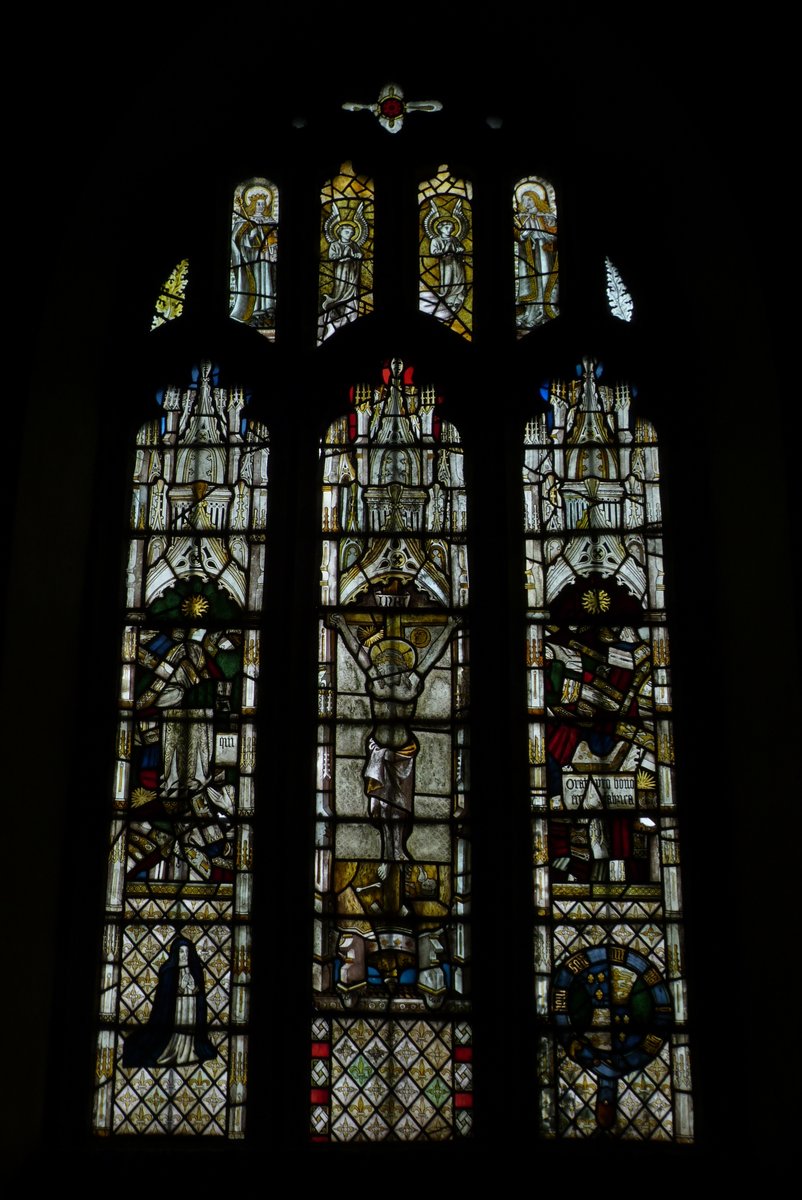

And Strata Marcella. F. 1170, like Cwmhir from Whitland Abbey, by a Welsh lord, Owain Cyfeiliog, who retired there. No trace above ground, but you can see the earthworks in the right light from the air so had a go.
Nave either lengthened or shortened. Who knows. Needs digging up


Nave either lengthened or shortened. Who knows. Needs digging up

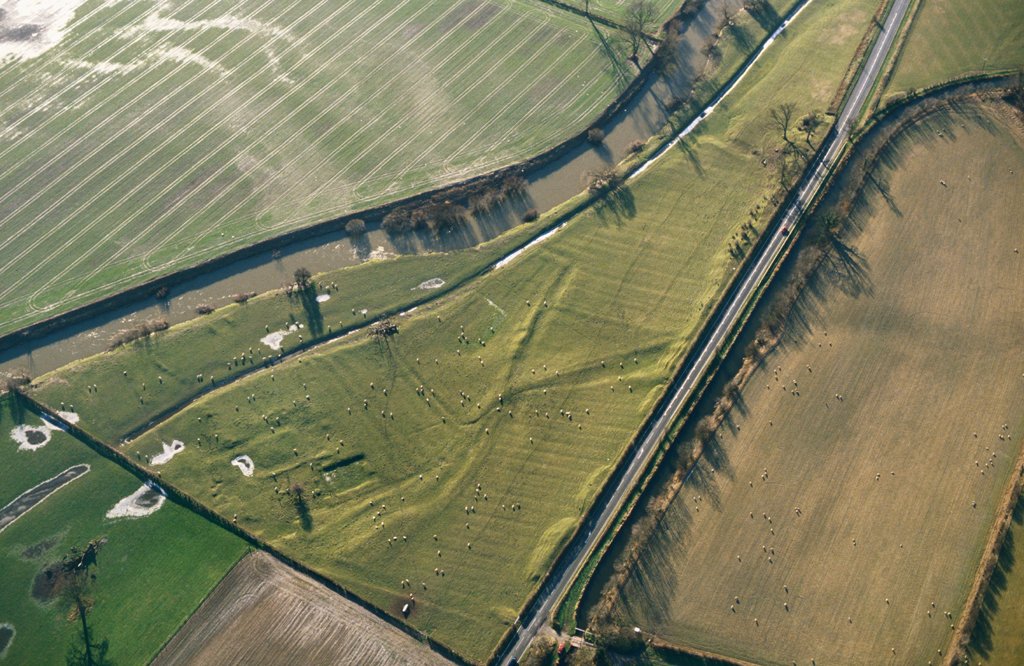
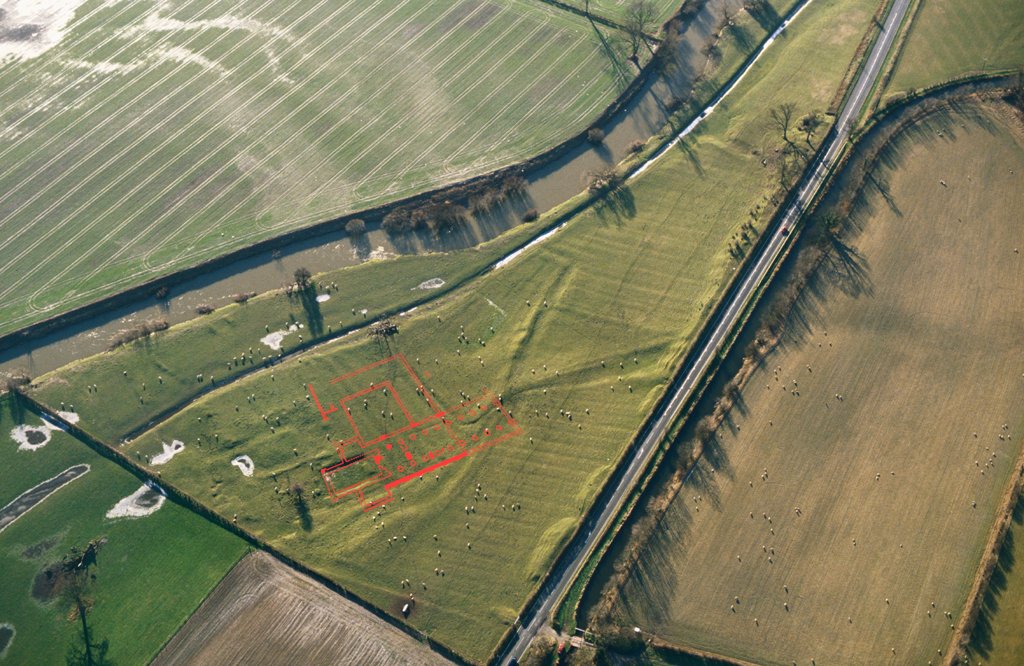
Didn't actually visit Strata Marcella (its a field!!) but did go to Buttington, the next parish up, and saw the ludicrous stiff-leaf font which is likely a capital from the abbey.
So could claim Powys monastery bingo. though maybe I just went to Buttington as it has a funny name


So could claim Powys monastery bingo. though maybe I just went to Buttington as it has a funny name



We begin Pembrokeshire with Caldey Priory, essentially a soft-pedalled cell of St Dogmaels Abbey with only one monk ever recorded, but on an 6thc site. However it did have a tiny full claustral range! The 13thc church (rubbish spire prob 15/16thc) was restored to worship 1897-9. 







Haverfordwest Priory, oh look a Norman lord founded an Austin Priory beginning 13thc, oh look it's aisleless and cruciform. Tower not over crossing weird flex though. Looks a bit grim today what with bypass in front of it. also the E arm fell down boo. 







also further up the river in centre of Haverfordwest there was a Dominican Friary. There were only 5 mendicant houses in Wales but you can see why it's not worth bothering with them when they always just have shopping centres over them (also no 25" OS @natlibscotmaps so whatever) 

6" it is! Monkton/Pembroke Priory, Benedictine, f.1098 by Anglo-Norman magnate Arnulf de Montgomery. £57 net at diss, priory church became a parish and that rarely bodes well for finding the claustral ranges (GRAVES). though vaults under Monkton Hall to SE prob guest house. 







so this is the E crossing face of Pill Priory, founded, like Caldey from St Dogmells, c.1200 (we'll talk more about Tironian status when we do the mother house). £52 net, never large. the surviving E face of the crossing is probably from the initial c.1200 build. and there it is. 







Slebech Preceptory, f.1161, Knights Hospitaller. Ruined church is perhaps theirs, or always parochial. New parish church was built 1844-8 because the Baron of Slebech Park wanted parishoners orf his land.
Tower is 12thc maybe? can't tell because there's weeds all over the bugger


Tower is 12thc maybe? can't tell because there's weeds all over the bugger



Finally St Dogmaels Abbey, mother of Caldey and Pill. £87 net 1535/6. Interesting as affiliated to Sainte-Trinité de Tiron, a separate Tironensian order: English houses dissolved or transferred under 14thc Alien Priory suppressions. Big chunk of N transept by 19thc parish church. 





somehow I did all of England without breaking my thread but barely a third through Wales I manage it. whatever, continue here
https://twitter.com/DrJACameron/status/1355905598756368387
So next Gaerfyrddin (Carmarthenshire) and Ceredigion (Cardiganshire), then Gwynedd (NE) and finally Clwyd (NW, and I own the Pevsner/BoW for that one phew) 

Cardigan Priory, net £34, small cell f. from Chertsey Abbey in Surrey before 1165. Church now parochial with no sign indication it was monastic. Big ol' stone box nave, but chancel with early Perp windows looks like last quarter 14thc I guess? who knows. quite fancy for Wales 





Llanllyr Abbey, Cistercian women, f. from Strata Florida before 1197. £57 net. Part of ranges incorporated into small mansion demolished in 1830. The reputed site of a chapel (marked on 25"er) excavated in 2014, but all that was found were signs of the mansion's formal gardens. 





And Strata Florida, f.1164 by a Norman lord, but changed its allegiance to the Welsh which didn't help its fortunes in long run and came in at only £118 in 1535. This site built from 1184. Can't find a full precinct plan to overlay. All about that famous drainpipe door really. 


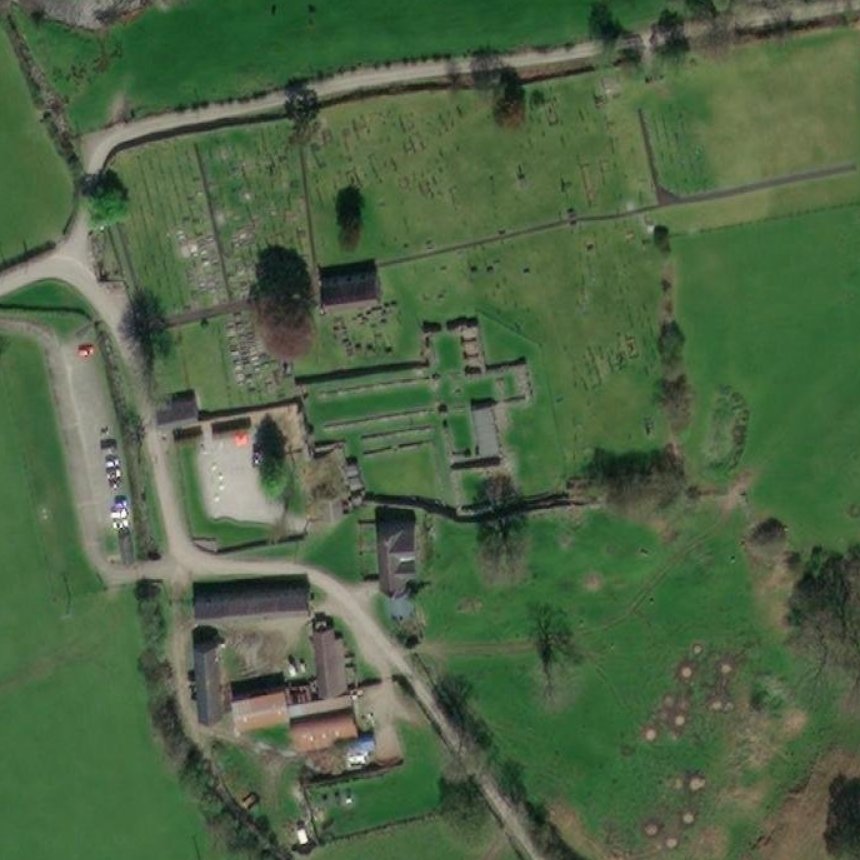


well blow me down we actually know loads about Carmarthen Franciscan Friary. At the dissolution was stuck between plans to move St Davids see there or to make it a grammar school so it wasn't demolished immediately. Later it was covered by walled mansion. Then Tesco, then Wilkos. 







I could position it fairly precisely because of these cottages round the back of the Poundland car park that were built over the nave 


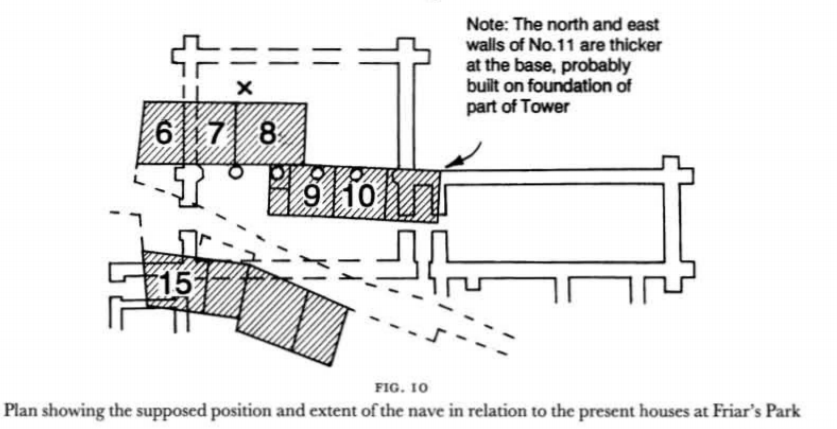
For the Austin Priory in Old Carmarthen, f.1125 on an ancient monastic site, much less. In fact nothing above ground, except the precinct gateway is built into some cottages. Some footings of the church were traced under the playing field in 1979 though 



Kidwelly Priory f.1110 from Sherborne Abbey, Dorset, £38 net/29 gross (I think, prob need to figure these out better a priori)
Bit like Cardigan probably explains chancel with sedilia of which there's not many of in Wales. This would be more exciting for me six years or so ago.


Bit like Cardigan probably explains chancel with sedilia of which there's not many of in Wales. This would be more exciting for me six years or so ago.
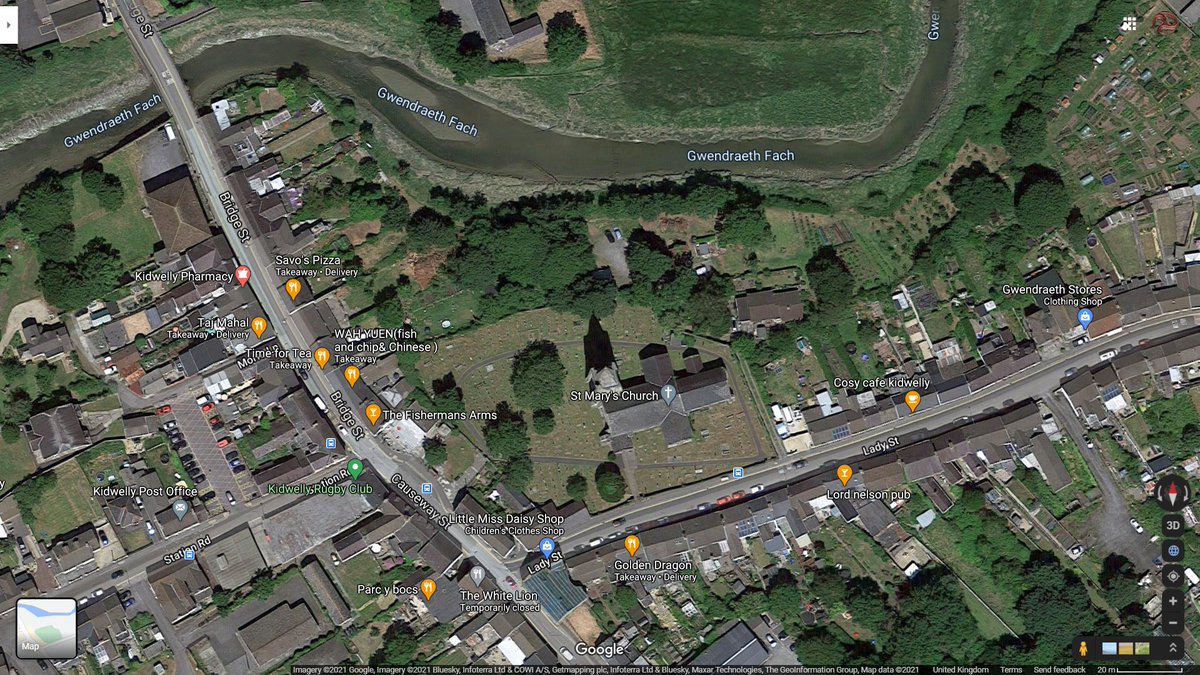


Talley Abbey, f.1184-9 by Rhys ap Gruffydd, the last Premonstratensian house in Britain and the only in Wales. The original plan for the church, some 70 m long (longer than Strata Florida or any Premont church in England) was abandoned probably due to the Lord Rhys' death in 1197 





Finally Whitland Abbey, f. 1140 directly from Clairvaux by 1st Norman bishop of St Davids, supported by The Lord Rhys, moved here 1151. Paid much after supporting Owain Glyndwr beginning of 15thc, bowed out at £135 net. Scant remains. Garden wall marks church S wall basically. 





Told you this wouldn't take long. Tune into tomorrow (possibly) for the next exciting episode of MonasteryQuest™!
ICYMI, you can also see fruits of the first English series, with the link to the first twitter thread from the toilet-roll-panic times here
stainedglassattitudes.wordpress.com/category/monas…
ICYMI, you can also see fruits of the first English series, with the link to the first twitter thread from the toilet-roll-panic times here
stainedglassattitudes.wordpress.com/category/monas…

Llanfaes Franciscans, f. c.1240 by Prince Llywelyn of Gwynedd in a thriving town until English usurped it w Beaumaris. Friary held on till the dissolution, and W part of church survived till the mid 19thc as a granary. It's 20 m N of the concrete turning circle for WW2 seaplanes. 





2.5 miles N: Penmon Priory, ancient 7thc site but reformed as Augustinian due to Llywelyn Fawr again. Wow it's got a big E arm hasn't it. Impressive mid 12thc Romanesque arches to nave and S transept (doing this without a Pevsner is like those dreams where you do an exam nude) 







Another mile and a half north we get to Puffin Island (Ynys Lannog) a 5thc hermitage that became a cell of Penmon. There's a 12thc church tower. How do I go here. Apparently it's owned by some peerage person so I'm not allowed. Not fair. I want to go to Puffin Island 


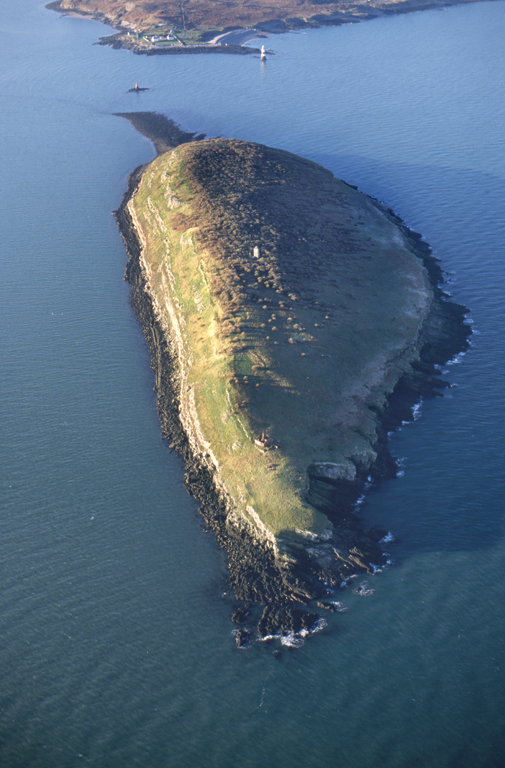


Beddgelert Priory, also very old proper Welsh site made Augustinian 13thc, becoming parochial after dissolution (£70 net). Became Parish church, no wonder, look at these transept arches and chancel lancets: isn't what most Welsh parish churches look like ooh no.
Also wanna go.


Also wanna go.



Bangor (cathedral city of course) Dominican friary f. c.1250. Well it's one of two places. One where stuff has actually been found which I'll do an overlay of sure but it was probably either an earlier site before they moved inland [where nothing has been found] or another house 





another island site, Bardsey, burial place of Deiniol first bishop of Bangor. Again under the early 13th Austin reform became an abbey that was valued £46 net in 1535. Plan I found with 13thc not very revealing. Island more accessible than Puffin one, you go from Porth Meudwy 







Finally, a more standard build: Cymer Abbey, f.1198 from Cwmhir (the stupidly big nave one). Like that and other remote Cistercian houses (e.g. Sawley), was cut back from original plan with no E arm. The sedilia are some of the (stylistically) earliest. maybe they reset them. idk 






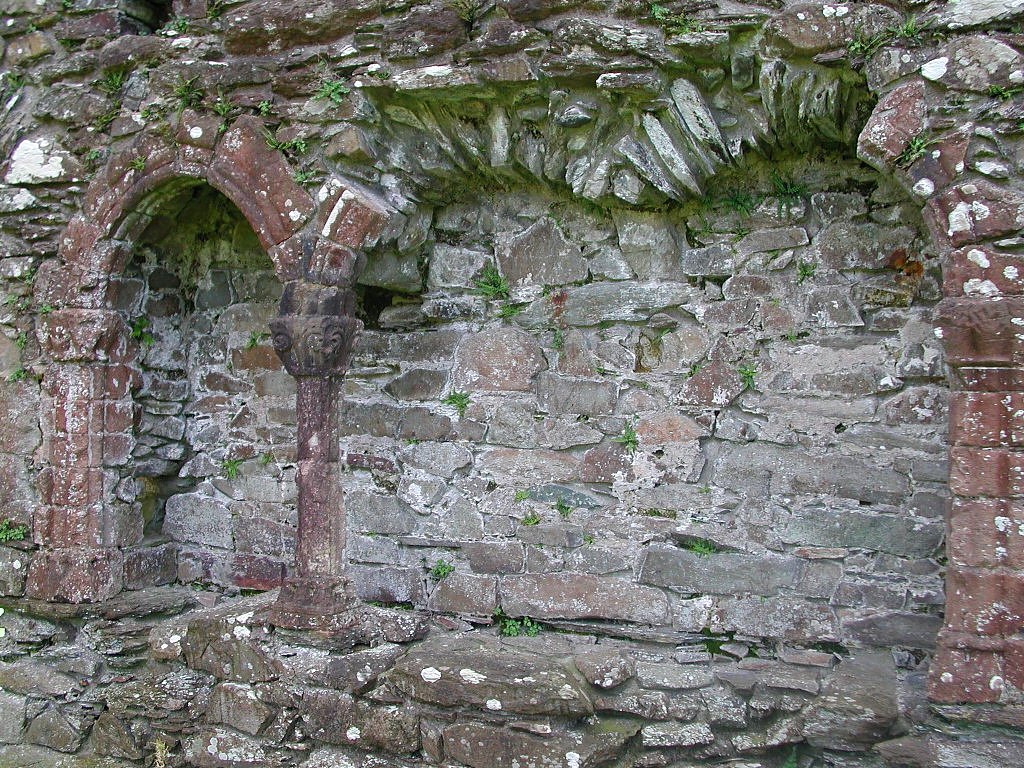
I have an (actual) Pevsner for the last bit although I have sadly been to none of them.
I'd bomb down to Valle Crucis tomorrow though if I could, though this will be good preparation for a more rehearsed bomb
I'd bomb down to Valle Crucis tomorrow though if I could, though this will be good preparation for a more rehearsed bomb

I know, if I was after seriously massive sophisticated medieval masonry builds here I really ought to visit the Edwardian castles from the Royal Works. 

Evidently did not read the BoW entry for Denbigh Carmelite Friary, the E arm of which was used as a malthouse until the roof burnt off in 1898. Originally had a timber framed crossing spire (indications of its wall plates). Parts of E range to S in Abbey cottage. 4 friars in 1538 







Rhuddlan Dominicans: we actually kinda have f. date for once, c.1258. E range and poss the church stoof when the Bucks visited mid-18thc, but just bits built into farm buildings now.
Archive images confused w. fragments at parish church but the owner's put some up on Google Maps.



Archive images confused w. fragments at parish church but the owner's put some up on Google Maps.




Valle Crucis Cistercian Abbey, f. 1201 from Strata Marcella by Madog ap Gruffydd of Powys. Church E and W fronts survive to nearly full height as well as E range. Modestly sized but impressively detailed mid-13thc build, comfortable if not unfraught existence as a border house. 







Maenan Cistercian Abbey, not in Clwyd BoW, but hardly matters as nowt above ground. Originally f. 1186 in Aberconwy: Edward I made them bugger off downriver 1286 to make way for his new fortifications. Extensively demolished 1539/40 and its materials shipped to Caernarfon. 1/2 





19thc house on site, now hotel. Took a fair few overlays. Conjectural plan from trenching when car park was expanded in the 1960s (prefer the retro chicken-in-basket look). The A470 (which is Wales' Route 66 afaict) was straightened 1982. Poss a lot more to find here. 2/2 



And FINALLY. Basingwerk Abbey (Greenfield). Not the best environs these days. f. 1131 as Sauviniac by the Earl of Chester, moved here 1157 when it became affiliated to Buildwas in the big Cistercian switchover. Standard plan, mostly early 13thc. Best surviving part the refectory. 







Blimey though. Look at this lad in the chapter house at Basingwerk. Big lad.
ACKNOWS:
Base dataset from arcgis.com/apps/webappvie…
Much info from monasticwales.org and plans from medievalheritage.eu
Also lots of Cistercian stuff from Mr Harrison at dhi.ac.uk/cistercians/ab…
ACKNOWS:
Base dataset from arcgis.com/apps/webappvie…
Much info from monasticwales.org and plans from medievalheritage.eu
Also lots of Cistercian stuff from Mr Harrison at dhi.ac.uk/cistercians/ab…

Google Map, but I'll refine, and drop data by order into my Valor map soon (except for the mendicants, who are next sequel?). Drop a Ko-fi if you feel obliged or use it for owt. May want to get one of my hi-res cathedral plan comps
ko-fi.com/stainedglassat…
google.co.uk/maps/d/u/0/edi…
ko-fi.com/stainedglassat…
google.co.uk/maps/d/u/0/edi…
also I broke the thread in Powys somehow and orphaned the most amazing house so that's here
https://twitter.com/DrJACameron/status/1355891604129800193
Was fascinating to see how Welsh monasteries were split between Anglo-Norman colonisation and Welsh princes reforming ancient sites/founding new French reformed daughter houses though, before Edwardus Malleus smashes shit out of everything. Politics of all that bit beyond me tbh
easier said than done this "adding Welsh houses to my old Valor map" malarkey
maybe I should be using a grown-up GIS system rather than this janky shower
maybe I should be using a grown-up GIS system rather than this janky shower

Basically I think it'd be quicker just to reimport the Valor map from scratch. I mean most of the effort was working out the classification system and icons and it's not too hard to reapply it if I keep a copy. Still good lesson: don't keep your important eggs in Google's baskets
Anyway here's the map coloured to something like my England map.
DID YOU KNOW
There were NO Benedictine Abbeys in Wales. Just one Austin (and the reformed ascetic orders that were always abbeys)
google.co.uk/maps/d/u/0/edi…
DID YOU KNOW
There were NO Benedictine Abbeys in Wales. Just one Austin (and the reformed ascetic orders that were always abbeys)
google.co.uk/maps/d/u/0/edi…
the Welsh north with Austins and Anglo-Norman colonisation of the south coast with Benedictines really is obvious though. with sprinkling of Cistercians everywhere. maybe I will write a thing
Llanthony is the outlier but for all intents and purposes it's an English house and hence why despite the fancy church build it died on its arse 
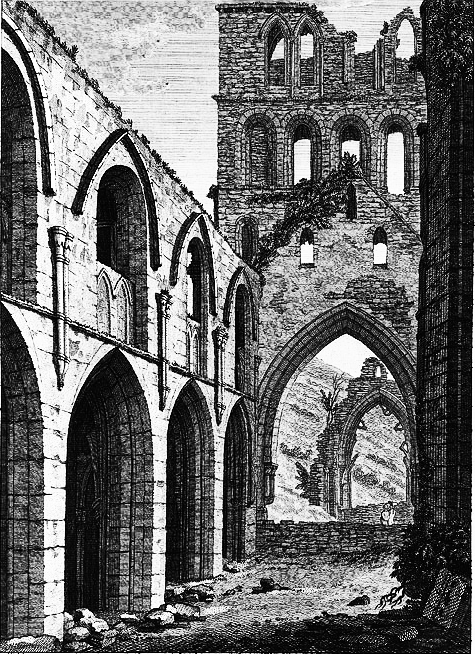
Right ok whatever I did it. No friaries. If I ever do them all (poss unlikely tbh) they will be separate because I've run out of layers anyway
google.co.uk/maps/d/u/0/edi…
google.co.uk/maps/d/u/0/edi…
A FLOWER?
Well Tironensian (like most orders' names) just comes from the name of the mother house, Tiron, which just comes from Terre as far as I can tell. could be wrong. but that's the closest I could find for "earth"
Well Tironensian (like most orders' names) just comes from the name of the mother house, Tiron, which just comes from Terre as far as I can tell. could be wrong. but that's the closest I could find for "earth"
I forgot I corrected all the original low-number lat/lons in Google Maps so they were all over the crossing towers and that got lost updating it so I'm gradually dragging them all a bit east mostly now. Revision. also doesn't take much mental effort on my part
• • •
Missing some Tweet in this thread? You can try to
force a refresh






